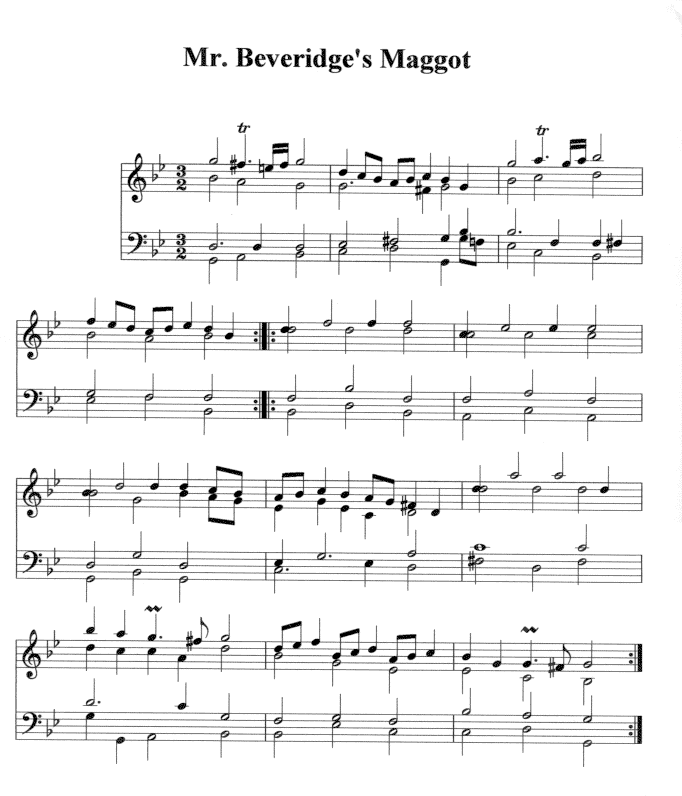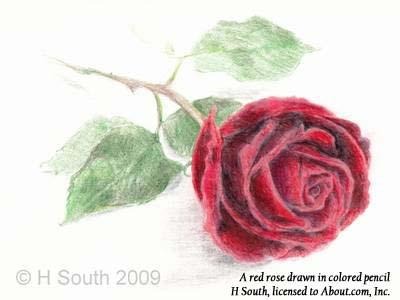
How to Dance Mr. Beveridge's Maggot
To be fond of dancing was a certain step towards falling in love -Pride and PrejudiceMany English Country Dances, like American contra dances, are danced to a pair of phrases of music played AABB -- i.e. the first phrase is played twice, and then the second twice. In contrast, the generally accepted version of Mr. Beveridge's Maggot--a version usually attributed to Pat Shaw--has the structure AAB. This is the version given here. When Cecil Sharp interpreted this dance for modern consumption, he decided he could not get all the instructions to fit into so little music, so he published a dance to fit AABB. Cecil Sharp's version is also widely known, and is given in Palmer's Pocket Playford.* This dance was originally printed in Playford's Dancing Master in 1695. Although neither this particular dance nor the duple minor formation it is in were being used in Jane Austen's day, the dance is a very 'cinegenic' dance. I'm not here giving the Cecil Sharp version which has a longer B part dance sequence to fill out a repeated B part (even though the original clearly says play the second strain but once). I'm here giving a closer-to-original Dancing Master (1695-1728) version. This is the sequence they dance in the movie Emma, but in that movie they dance the sequence just once then go into a snowballing cast off. P&P2 has the same non-Sharp B part as given below and used in Emma (with the dramtaic up and back) but for the A part has everyone r.h. turn, l.h. back, then 1s cross, cast, cross back up. I suspect this change from the original was probably inspired by the need for a more dramatic face-to-face beginning to a dance that was to be the vehicle for a 'battle' between the two protaganists, without giving away altogether a dance which offers the lovely, camera-confronting, film-effective, 4-in-line (with Darcy and Elizabeth 'trapped' side-by-side in the middle) up and back figure.** A Maggot when referred to in country dancing means An extravagant notion; a whim.
The first Man crosses over and goess back to back with the 2nd Woman. Then the 1st woman crosses over and goes back to back with the 2nd Man at the same time (in short, 1s cross right shoulder to other side- possibly giving right hands momentarily, then after a bow to 2s below, do-si-do-ing with 2s below) A2 Then meet and turn Shoulder over right shoulder with 6 steps (2 bars) then the 1st man turns the 2nd Woman with his right hand, and 1st Woman turns the 2nd Man with her right hand at the same time in 12 steps (4 bars), then 1st Couple take left hands and turn into their own places with 6 steps (2 bars) B The 1st couple cross over into the 2nd couple's place by pulling on left hand, passing left shoulder and casting down on opposite side while 2s meet partner and lead up, and go back to back with their Partner while 2s cast out with 6 steps onto outside end, then all four lead up hands abrest with 2 steps and a rise, then back with 2 steps and a rise, then 1st man and Woman cross (Woman in front) as they lead up and go the partial Figure through; and cast off into the 2nd couple's place while 2s meet partner again and lead up.
**Information from Earthly Delights and The Hawaiian Contra Dance Page. Mister Beveridge's Maggot appears on Popular English Country Dances of the 17th & 18th Centuries by the Claremont Country Dance Band and is also part of a medley on the CD English Country Dances from Playford's Dancing Master by the Broadside Band. Sheet Music for this song can be found on the Republic of Pemberley's website in Easy and Complex formats.
*Thanks to Hugh Stewart of the Round, in Cambridge, for this information.
If you don't want to miss a beat when it comes to Jane Austen, make sure you are signed up to the Jane Austen newsletter for exclusive updates and discounts from our Online Gift Shop.



2 comments
Was Mr. Beveridge’s Maggot considered a contra or a polonaise? Thanks.
Jane
I’m teaching a group of teenagers this dance. I understand this so far. But what happens next. Do the ones start again, or do the twos start now. I don’t know how they progress down the line. I have 10 couples. Please help me figure this out.
Adriana Clark
Leave a comment
This site is protected by reCAPTCHA and the Google Privacy Policy and Terms of Service apply.